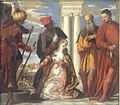Justina of Padua
| Saint Justina of Padua | |
|---|---|
 Saint Justina by Bartolomeo Montagna | |
| Martyr | |
| Died | ~ 304 AD |
| Honored in | Roman Catholic Church |
| Feast | October 7 |
| Attributes | young woman setting a cross on the head of the devil while holding a lily in her hand; young woman with a crown, palm, and sword; young woman with a palm, book, and a sword in her breast; young woman with a unicorn, symbolizing virginity, and palm; young woman with both breasts pierced by one sword; young woman with Saint Prosdocimus; depicted as nun; young woman with Saint Scholastica |
| Patronage | Padua; Palmanova |
Saint Justina (Justine) of Padua (Italian: Santa Giustina di Padova) is a Christian saint who was said to have been martyred in the year 304 AD. Justina was said to have been a young woman who took private vows of chastity and was killed during the persecutions of the Roman emperor Diocletian. She is a patron saint of Padua. Her feast day is October 7.
Life
Medieval histories describe her as a disciple of Saint Peter the Apostle. Thus, Saint Prosdocimus, the first bishop of Padua, is said to have been Justina's spiritual father; his histories state that he was sent from Antioch by Peter. This however is physically impossible as Justina being a young woman in 304 AD could not have known Prosdocimus as he died in approximately 100 AD.
She is mentioned in Foxe's Book of Martyrs. It was under the 10th Persecution in 303 AD while Diocletian was Emperor of Rome. It says:
"Cyprian, known by the title of the magician, to distinguish him from Cyprian, bishop of Carthage, was a native of Antioch. He received a liberal education in his youth, and particularly applied himself to astrology; after which he traveled for improvement through Greece, Egypt, India, etc. In the course of time he became acquainted with Justina, a young lady of Antioch, whose birth, beauty, and accomplishments, rendered her the admiration of all who knew her. A pagan gentleman applied to Cyprian, to promote his suit with the beautiful Justina; this he undertook, but soon himself became converted, burnt his books of astrology and magic, received baptism, and felt animated with a powerful spirit of grace. The conversion of Cyprian had a great effect on the pagan gentleman who paid his addresses to Justina, and he in a short time embraced Christianity. During the persecutions of Diocletian, Cyprian and Justina were seized upon as Christians, the former was torn with pincers, and the latter chastised; and, after suffering other torments, both were beheaded."
Veneration
The Paduan Basilica and Abbey of Santa Giustina houses art dedicated to the saint, including the Martyrdom of St. Justine by Paolo Veronese. The Abbey complex was founded in the 5th century on Justine's tomb, and in the 15th century became one of the most important monasteries in the area, until it was suppressed by Napoleon in 1810. In 1919 it was reopened. The tombs of several saints are housed in the interior, including those of Justina, Prosdocimus, St. Maximus, St. Urius, St. Felicitas, St. Julian, as well as relics of the Apostle St. Matthias and the Evangelist St. Luke.
Charles Borromeo dedicated the chapel of the Collegio Borromeo (built in 1561) in Pavia to her.
Patronage
Saint Justina is, after Saint Mark, the patroness of Venice.[1]
Gallery
-

Basilica of Saint Justina, Padua
-

Saint Justina with the Unicorn, circa 1530, by Moretto da Brescia
-

Paolo Veronese, The Martyrdom of St. Justine
References
See also
External links
| Wikimedia Commons has media related to Justina of Padua. |